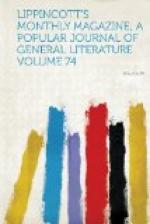The chemist now pulled a manuscript from his pocket and read from it as follows: “The quantity of light decreases with disproportionate rapidity by reduced consumption; for, as experiments have shown, when consuming only two feet per hour, eighty-five per cent. of the gas is lost; with two and a half feet the loss is sixty per cent.; and with three and a half feet it is thirty-four per cent. of that derived from the gas when burning the full quantity for which the burner is constructed. In some experiments made upon this matter under the direction of referees appointed by the London Board of Trade the loss at the other extreme is given. They report: ’Instead of the gas giving increased light as the rate of consumption is increased, it will be seen that in every case there is a point beyond which the light decreases relatively to the proportion of gas consumed. In every case, too, this point lies far below the maximum of gas-consumption, observing the turning-points in the case of the different burners.’ Again, every burner has a certain amount of gas which it will consume to the greatest advantage as to both light and economy; which in a completely-regulated burner is quickly found, and the delivery fixed by the small tap. When the gas is issuing from the burner at so low a pressure that the flame is just on the point of smoking, the maximum effect for the quantity of gas consumed in that particular burner is attained, because in that case the quantity and intensity of the light are most advantageously balanced. For the same reason, the burner best suited for light is one in which the jet-openings are proportionately large, so as to prevent as much as possible too great contact with the air in the lower part of the flame. In case the air-currents disturb the light, it is necessary to turn on a stronger flow, which secures steadiness, but sets economy at naught.”
“It would be a good thing,” said the young fellow, interrupting him, “if some person would invent a burner that should heat the gas before its discharge. We could then get a perfect combustion of the carbon, and so greater brilliancy and economy.”
“That is a very common error. Mr. Leslie’s burner was designed on that very theory: the result was contrary to expectation.”
“What was the form of the burner?” inquired our host.




